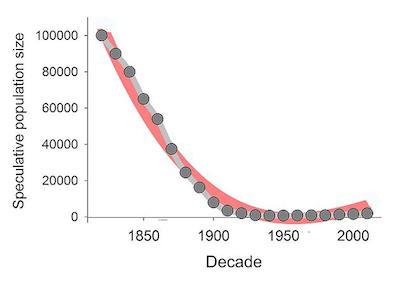
Grizzly bear populations today are just a very small fraction of what they once were, and not large enough to justify delisting the species, according to a wildlife biologist/Grizzly Times
Claims by the Interagency Grizzly Bear Study Team that the grizzly bear population in the Greater Yellowstone Ecosystem is growing and genetically diverse are off-base, according to a wildlife biologist who long has studied the population and spent 17 years doing research for the team.
The analysis promoted by the IGBST a week ago shows that the bear population in the ecosystem has continued to grow since the 1980s. Results indicate that the effective population size of Yellowstone grizzly bears, or the number of individuals that contribute offspring to the next generation, has increased 4-fold over a 25-year period, the report maintained. This provides evidence that Yellowstone grizzly bears are approaching the effective size necessary for long-term genetic viability, the study said.
"The increase in effective size of the Yellowstone grizzly bear population over the past several decades, with no significant change in genetic diversity, supports evidence of population growth based on traditional surveys," said Pauline Kamath, USGS ecologist and lead author of the study. "This is a key genetic indicator of a population’s ability to respond to future environmental change."
But Dr. Dave Mattson, who has studied bears for three decades, said the claims can't be supported.
“For this to happen, population growth rates would have needed to exceed anything known, or even possible, for grizzly bears, and the resulting putative size of the population would be far in excess of even the most optimistic current estimates,” said Dr. Mattson in a release.
Dr. Mattson maintains that the report was issued to support efforts in Wyoming, Idaho, and Montana to remove the grizzly bear from Endangered Species Act protection.
On the Grizzly Times blog, writer Louisa Willcox, who long has followed wildlife issues in the ecosystem, argues that the recent upturn in the grizzly population is too small to declare success in recovering the species, particularly when you accept that there once were 100,000 grizzlies roaming the United States.
The fact is that the relatively small increase in numbers is very vulnerable to reversals. It is hard to grow a grizzly bear even under the best of conditions. Their reproductive rates are the lowest of any mammal in North America. And, grizzly bears cannot withstand high levels of killing, as has occurred in recent years. Even the government concedes that the Yellowstone population has not been growing since 2002, and may be declining.
While there is no magic population size that protects bears from extinction, you might think so to hear the number 500 bandied about. That is the target for Yellowstone grizzly bear recovery established in the 1992 Grizzly Bear Recovery Plan. It was not set as a result of any rigorous scientific or social process (or even the most basic analysis of the number of bears the ecosystem could support), but because that was roughly how many bears were estimated in the population at that time.It is important to note that the recovery target was set by technocrats in the government, catering to politically well-connected hunters and ranchers -- not the broader public. During the public processes related to the Recovery Plan and the seven other decision documents since then, the vast majority of non-government scientists and people who submitted comments challenged the 500 number as being far too small to ensure a healthy population, especially given development pressures, climate change, and excessive human-caused mortalities. These comments were virtually all ignored by the US Fish & Wildlife Service and the states.



Add comment